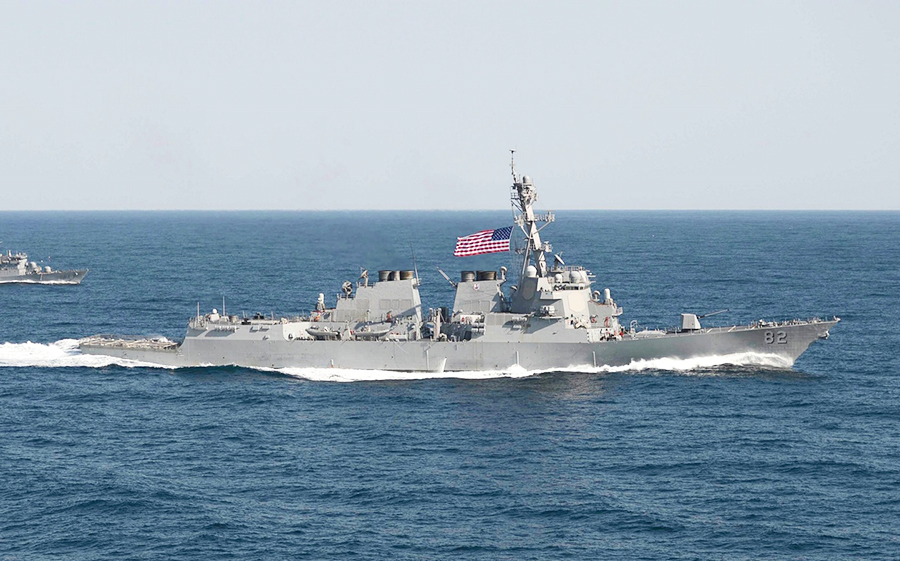Speculation had simmered for weeks that the United States intended to conduct naval patrols in the South China Sea to challenge Beijing’s territorial claims there. Pentagon leaders seemed especially eager to defy China’s position that building “reclaimed” or artificial reefs or islands also created rights to new territorial waters surrounding those creations. The widespread speculation was confirmed on October 27, when the Navy sent the guided-missile destroyer USS Lassen on a “freedom of navigation” patrol within 12-miles of a man-made islands.in the Spratly chain.

USS Lassen went on patrol around the disputed Spratly archipelago. Photograph: Us Navy/Reuters
Beijing’s reaction was immediate and vehement. Chinese naval vessels monitored, followed, and warned the Lassen, although they did not, fortunately, take any further action. The Chinese foreign ministry issued a curt rebuke to the United States, urging Washington to “immediately correct its mistake and not take any dangerous or provocative acts that threaten China’s sovereignty and security interests. U.S. officials clearly intend to ignore that protest and plan to conduct additional patrols.
This move on Washington’s part is a dangerous escalation of already worrisome tensions in the South China Sea. It is understandable that, as the world’s leading maritime power, the United States is unwilling to accept Beijing’s extremely broad territorial claims in that body of water. The full extent of China’s claims would cover nearly 90 percent of the South China Sea. Given the extensive oceanic commerce that passes through that area (some $5 trillion per year), much of which is vital to South Korea, Japan, and other U.S. allies in East Asia, Washington’s recalcitrance is unsurprising.
The creation of reclaimed and man-made islands and reefs also creates a murky issue under international law. Although Beijing has never issued a formal declaration, the implicit Chinese position is that the waters surrounding such entities are the same as territorial waters around other islands, and that includes both a 12-mile limit with full sovereignty and a larger exclusive economic zone. Since such sizable constructs have never existed before, international law on the subject is unclear. Wholly artificial structures do not lead to existence of a sovereignty zone, but reclaimed land from the sea may be another matter. Yet Washington has chosen to summarily reject China’s position.
U.S. Secretary of Defense Ashton Carter states that, “the United States will fly, sail, and operate wherever international law allows, as we do around the world, and the South China Sea is not and will not be an exception.” It is hardly surprising that the United States would insist on a firm defense of international navigation rights. But there are less confrontational ways to pursue that objective without the kind of “in your face” challenge symbolized by the Lassen voyage and future planned patrols. A diplomatic statement asserting that Washington does not necessarily accept claims to a 12-mile sovereignty belt around artificial or reclaimed islands, accompanied by highly visible U.S. naval patrols in the South China Sea that nevertheless remain outside the claimed 12-mile limits, would have been an appropriate compromise. It is unfortunate that U.S. officials instead chose to adopt a much more provocative stance.
Chinese leaders also are watching to see what the United States does about the artificial reefs that both Vietnam and the Philippines have built. Those projects are less numerous and smaller than China’s versions, but they raise the same questions under international law. That creates a dilemma for U.S. officials. If they send naval vessels into waters close to such islands, the action is likely to annoy Hanoi and Manila and undercut their territorial claims. However, if the U.S. Navy conveniently fails to assert navigation rights against those claims, Chinese officials will consider that clear evidence that Washington is applying a double standard. That suspicion is already prominent with regard to U.S. actions regarding the overall, multi-sided territorial controversies involving the South China Sea. Despite assurances from both the Bush and Obama administrations that the United States remains neutral with respect to the disputes, Washington’s unsubtle policy tilts toward Vietnam and the Philippines suggest an “anybody but China” attitude.
Beijing’s suspicions about U.S. motives in the South China Sea are already at a high level. The Lassen incident and the planned additional naval patrols are certain to intensify those suspicions. The South China Sea dispute has now emerged as the most prominent issue that could irrevocably damage relations between the United States and China. Naval patrols brazenly challenging China’s position regarding the man-made islands are unnecessarily provocative. Washington needs to take a step back before it ignites a major crisis.

